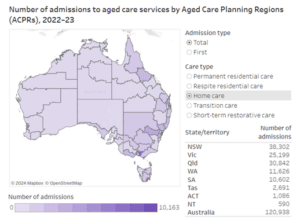The Retirement Living Council (RLC) is calling on the Australian Government to prioritise urgently needed aged care reforms following the release of new Australian Institute of Health and Welfare data.
The National Aged Care Data Clearinghouse 2022-23 statistics found that over the past decade the number of admissions to home care has increased by 267 per cent.
RLC Executive Director Daniel Gannon said these statistics - combined with Australia's ageing population - should ring alarm bells for the Australian Government.
"In every Australian city, governments are grappling with ambulance ramping, a shortage of hospital beds, an aged care sector bursting at the seams, historic low rental and retirement village vacancies, and unaffordable, red-hot housing markets," Mr Gannon said.
"This is all conspiring as Australia's population ages, bringing with it big socio-economic challenges including a 267 per cent increase to home care admissions over a decade.
"While the number of home care admissions has almost quadrupled over the last decade, this might be as good as it gets given the significant demographic changes expected in the coming years.
"In simple terms, Australia's aged care system is crumbling under the weight of increasing demand, propelled by an ageing population.
"Unfortunately, this year's federal budget didn't lay out a long-term plan for Australia's care challenges, which is plunging the country into a deeper care deficit.
"While $531 million was allocated to clearing the home care backlog and $1.4 billion to aged care digital infrastructure, these are short-term responses to a problem that is decades in the making.
"This comes at a time when the government still hasn't responded to the recommendations from the Aged Care Taskforce, having already had almost nine months to consider its recommendations."
Mr Gannon said the policy approach to care should include the strong value proposition of privately funded retirement villages to help provide more care in a more efficient way.
"Retirement villages provide scale for delivering these services efficiently by reducing travel costs incurred by service providers, increasing the frequency of service delivery, and enhancing the quality and type of services by leveraging those already living in these dense communities," Mr Gannon said.
The RLC has developed a new framework - Shared Care - to outline how government can address some of the problems associated with home care funding and delivery while removing transport inefficiencies and costly red tape.
Home care
The map below shows where "aged care admissions" occurred, which include those older Australians accessing home care services.
Notably over the past 12 months, 38,302 people in NSW accessed home care (32% of national total), while 30,842 Queenslanders (26%) and 25,199 Victorians (21%) accessed home care services.
This comes at a time when the waitlist to get a home care package has blown out, with more than 68,000 older Australians now waiting for assistance.
The Australian Institute of Health and Welfare report also reveals that in 2022-23:
- The largest share of home care admissions were at Level 2 (43%), followed by Level 3 (35%) and Level 4 (16%). Less than 1 in 16 (6.1%) home care admissions in 2022-23 were at Level 1.







